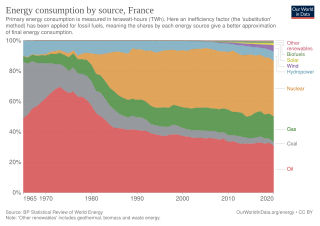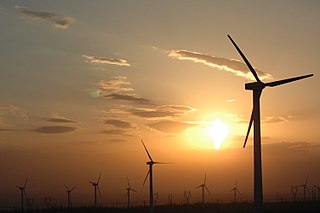Related Research Articles

Energy development is the field of activities focused on obtaining sources of energy from natural resources. These activities include production of renewable, nuclear, and fossil fuel derived sources of energy, and for the recovery and reuse of energy that would otherwise be wasted. Energy conservation and efficiency measures reduce the demand for energy development, and can have benefits to society with improvements to environmental issues.

SSE Airtricity is an energy company founded in Ireland in 1997, and now a subsidiary SSE plc. SSE Airtricity supplies and distributes electricity and gas to Northern Ireland and the Republic of Ireland.

According to the International Energy Agency, France has historically generated a very low level of carbon dioxide emissions compared to other G7 economies due to its reliance on nuclear energy. Energy in France is generated from five primary sources: coal, natural gas, liquid fuels, nuclear power, and renewables. In 2020, nuclear power made up the largest portion of electricity generation, at around 78%. Renewables accounted for 19.1% of energy consumption. France has the largest share of nuclear electricity in the world. The country is also among the world's biggest net exporters of electricity. The country is increasingly investing in renewable energy and has set a target of 32% by 2030.

Renewable energy commercialization involves the deployment of three generations of renewable energy technologies dating back more than 100 years. First-generation technologies, which are already mature and economically competitive, include biomass, hydroelectricity, geothermal power and heat. Second-generation technologies are market-ready and are being deployed at the present time; they include solar heating, photovoltaics, wind power, solar thermal power stations, and modern forms of bioenergy. Third-generation technologies require continued R&D efforts in order to make large contributions on a global scale and include advanced biomass gasification, hot-dry-rock geothermal power, and ocean energy. As of 2012, renewable energy accounts for about half of new nameplate electrical capacity installed and costs are continuing to fall.

Wind power in Texas, a portion of total energy in Texas, consists of over 150 wind farms, which together have a total nameplate capacity of over 30,000 MW. If Texas were a country, it would rank fifth in the world: The installed wind capacity in Texas exceeds installed wind capacity in all countries but China, the United States, Germany and India. Texas produces the most wind power of any U.S. state. According to the Electric Reliability Council of Texas (ERCOT), wind power accounted for at least 15.7% of the electricity generated in Texas during 2017, as wind was 17.4% of electricity generated in ERCOT, which manages 90% of Texas's power. ERCOT set a new wind output record of nearly 19.7 GW at 7:19 pm Central Standard Time on Monday, January 21, 2019.
Wind power in Ohio has a long history, and as of 2016, Ohio had 545 megawatts (MW) of utility-scale wind power installations installed, responsible for 1.1% of in-state electricity generated. Over 1000 MW more were under construction or pending approval. Some installations have become tourist attractions. There has been a sudden increase in generating capacity, as total wind power capacity in the state was just 9.7 MW in 2010. By 2019, there were 738 MW of capacity, which generated 1.71% of Ohio's electricity.

Sweden consumes about 150 terawatt hours of electricity per year, of which about 19.8 TW·h (14.2%) was generated from domestic wind power resources in 2019, up from 2.4% in 2010 and 0.3% in 2000.

China is the world leader in wind power generation, with the largest installed capacity of any nation and continued rapid growth in new wind facilities. With its large land mass and long coastline, China has exceptional wind power resources: it is estimated China has about 2,380 gigawatts (GW) of exploitable capacity on land and 200GW on the sea. Wind power remained China's third-largest source of electricity at the end of 2021, accounting for 7.5% of total power generation.

Energy in Mexico describes energy and electricity production, consumption and import in Mexico.

The renewable-energy industry is the part of the energy industry focusing on new and appropriate renewable energy technologies. Investors worldwide have paid greater attention to this emerging industry in recent years. In many cases, this has translated into rapid renewable energy commercialization and considerable industry expansion. The wind power, solar power and hydroelectric power industries provide good examples of this.

Iberdrola Renovables was a subsidiary of Iberdrola, headquartered in Valencia, Spain, which included companies in the domains of renewable energy, particularly wind power. The firm was the world's largest renewable energy firm: it was the world's largest owner-operator of wind farms, but also operated in the solar, hydro, biomass and wave power industries.

Community wind projects are locally owned by farmers, investors, businesses, schools, utilities, or other public or private entities who utilize wind energy to support and reduce energy costs to the local community. The key feature is that local community members have a significant, direct financial stake in the project beyond land lease payments and tax revenue. Projects may be used for on-site power or to generate wholesale power for sale, usually on a commercial-scale greater than 100 kW.

As of 2019, renewable energy technologies provide about 17.3% of Canada's total primary energy supply. For electricity renewables provide 67%, with 15% from nuclear and 18% from hydrocarbons.

Wind power in Montana is a growing industry. Montana had over 695 MW of wind generation capability by 2016, responsible for 7.6% of in-state electricity generation.
GE Wind Energy is a branch of GE Renewable Energy, a subsidiary of General Electric. The company manufactures and sells wind turbines to the international market. In 2018, GE was the fourth largest wind turbine manufacturer in the world.
Solar power in Georgia on rooftops can provide 31% of all electricity used in Georgia.
References
- ↑ "Consultancy on Wind Power Development. Publisher of the World Market Update Report". Archived from the original on 2009-02-12. Retrieved 2009-04-09.
- ↑ "Company Profile". Archived from the original on 2009-04-02. Retrieved 2009-04-08.
- 1 2 Milford, Edward. BTM Wind Market Report Archived 2011-08-16 at the Wayback Machine REW 20 July 2010. Retrieved: 6 August 2010
- ↑ Wind power by Paul Gipe, p. 358.
- ↑ Wind Energy in the 21st Century, p. 29.
- ↑ Wind power world market analysis
- ↑ BTM Consult foresees big things for China